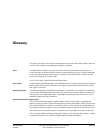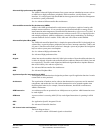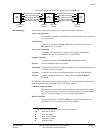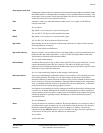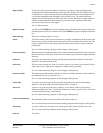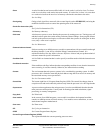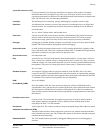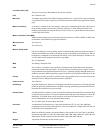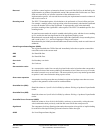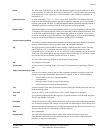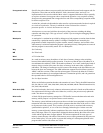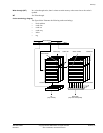
Glossary
ARM DDI 0363E Copyright © 2009 ARM Limited. All rights reserved. Glossary-9
ID013010 Non-Confidential, Unrestricted Access
Enabled exception An exception is enabled when its exception enable bit in the FPCSR is set. When an enabled
exception occurs, a trap to the user handler is taken. An operation that generates an exception
condition might bounce to the support code to produce the result defined by the IEEE 754
standard. The exception is then reported to the user trap handler.
Endianness Byte ordering. The scheme that determines the order in which successive bytes of a data word
are stored in memory. An aspect of the system’s memory mapping.
See also Little-endian and Big-endian
ETM See Embedded Trace Macrocell.
Event 1. (Simple) An observable condition that can be used by an ETM to control aspects of a
trace.
2. (Complex) A boolean combination of simple events that is used by an ETM to control
aspects of a trace.
Exception A fault or error event that is considered serious enough to require that program execution is
interrupted. Examples include attempting to perform an invalid memory access, external
interrupts, and Undefined instructions. When an exception occurs, normal program flow is
interrupted and execution is resumed at the corresponding exception vector. This contains the
first instruction of the interrupt handler to deal with the exception.
Exception service routine
See Interrupt handler.
Exception vector See Interrupt vector.
Exponent The component of a floating-point number that normally signifies the integer power to which
two is raised in determining the value of the represented number.
External Abort An indication from an external memory system to a core that the value associated with a
memory access is invalid. An external abort is caused by the external memory system as a result
of attempting to access invalid memory.
See also See also Abort, Data Abort and Prefetch Abort
Halfword A 16-bit data item.
Halt mode One of two mutually exclusive debug modes. In halt mode all processor execution halts when a
breakpoint or watchpoint is encountered. All processor state, coprocessor state, memory and
input/output locations can be examined and altered by the JTAG interface.
See also Monitor mode.
High vectors Alternative locations for exception vectors. The high vector address range is near the top of the
address space, rather than at the bottom.
Hit-Under-Miss (HUM)
A buffer that enables program execution to continue, even though there has been a data miss in
the cache.
Host A computer that provides data and other services to another computer. Especially, a computer
providing debugging services to a target being debugged.
HUM See Hit-Under-Miss.
IEEE 754 standard IEEE Standard for Binary Floating-Point Arithmetic, ANSI/IEEE Std 754-1985. The standard
that defines data types, correct operation, exception types and handling, and error bounds for
floating-point systems. Most processors are built in compliance with the standard either in
hardware or in a combination of hardware and software.




